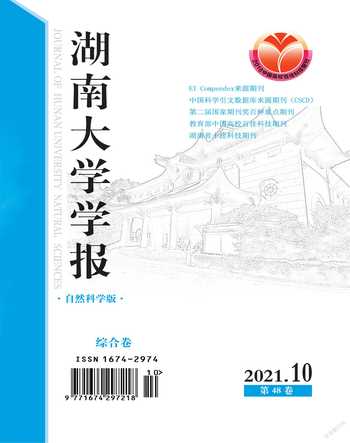一种基于LTVMPC改进的无人驾驶汽车路径跟踪控制算法
张维刚 张朋 韦昊 熊觉振



摘 要:在低附着路面情况下,针对现有以线性时变模型预测控制(LTVMPC)为基础的无人驾驶汽车路径跟踪精确性和稳定性问题,提出一种改进的控制算法. 以汽车动力学理论为基础,将四轮轮胎侧偏角和滑移率精确地表示为车辆状态量的非线性函数,在预测时域内对车辆状态方程线性化处理而求解雅可比矩阵时,为降低系统维度,将轮速作为非状态量,建立改进的三自由度车辆模型,在二次规划性能指标中加入横摆角速度跟踪误差项以提高路径跟踪性能,考虑质心侧偏角对跟踪精度和车辆稳定性的影响,修正参考横摆角,建立改进的LTVMPC. 在Carsim-Simulink联合仿真平台进行低附着系数路面情况下的双移线跟踪仿真,结果表明改进后的控制算法在保证实时性的前提下,提高了路径跟踪的精确性和车辆行驶的稳定性.
关键词:无人驾驶汽车;路径跟踪;线性时变模型预测控制;二次规划
中图分类号:U467.1 文献标志码:A
An Improved Path Tracking Control Algorithm
for Autonomous Vehicle Based on LTVMPC
ZHANG Weigang ZHANG Peng WEI Hao XIONG Juezhen
(State Key Laboratory of Advanced Design and Manufacturing for Vehicle Body,Hunan University,Changsha 410082,China)
Abstract:Under the case of low adhesion road,an improved control algorithm is proposed to solve the problem of the lack of accuracy and stability in the path tracking of autonomous vehicles based on Linear Time-Varying Model Predictive Control (LTVMPC). Based on vehicle dynamics,the slip angles and ratios of four tires are accurately expressed as the nonlinear function of vehicle state parameters. The Jacobian matrix is obtained by taking wheel speed as constant when linearizing the vehicle state equation in prediction horizon so as to reduce the dimension of the system,which aims to establish the improved 3-DOF vehicle model. The yaw rate tracking error is added into the performance index of quadratic programming to improve the path tracking performance and the influence of the slip angle of vehicle on the tracking accuracy and vehicle stability is considered to modify the reference yaw angle,which improves the overall performance of LTVMPC. The double lane change tracking simulation under the condition of low adhesion coefficient is performed on Carsim-Simulink co-simulation platform,and the results show that the improved control algorithm can increase the accuracy of path tracking and stability of vehicle while ensuring real-time performance.
Key words:autonomous vehicle;path tracking;Linear Time-Varying Model Predictive Control(LTVMPC);quadratic programming
路径跟踪是无人驾驶汽车自主行驶过程中的基本任务和关键环节,其主要目标是使车辆自动沿着规划路径安全稳定地行驶[1]. 当车辆行驶在低附着路面上时,由于此时车辆极易处于失稳状态,路径跟踪精确性和车辆行驶稳定性就面临着很大的挑战.
为了增强路径跟踪控制效果,相关研究人员提出了许多算法. 模型预测控制(MPC)由于能够有效处理系统约束、方便建立多输入多输出控制系统且具备前馈加反馈控制的优点,已经成为其中最有效的方法之一[2]. MPC首先利用已有模型来预测系统未来的动态,并将系统当前的状态作为初始状态,以某项性能指标达到最优为目标,形成一个有限时域开环最优化问题,通过在线求解该问题而获得最优控制量[3-4]. 由于在每个采样时刻都求解二次规划或非线性规划问题,当预测模型过于复杂或考虑过多的非线性约束时,计算量会过于庞大而限制其在车辆控制系統中的实际应用[5-6]. 为提高算法的实时性,线性时变模型预测控制(LTVMPC)往往作为一种次优的选择[7].
LTVMPC在每個时间步长内,将非线性车辆动力学模型在当前工作点连续线性化,且一般会将最优化问题转化为二次规划问题进行求解. 动力学预测模型是LTVMPC的核心,模型的精度和复杂度直接决定了路径跟踪的精确性和实时性[8]. 文献[9]使用三种不同精度的车辆模型来建立LTVMPC路径跟踪控制器,指出精度高的车辆模型可以有效提高跟踪性能,但复杂的模型会相应增加计算负担,当模型的维度达到一定阶次后,性能的提升幅度有限. 文献[10]基于简化的三自由度车辆动力学模型建立了典型的LTVMPC轨迹跟踪控制器,但由于未考虑左右轮胎受力的差异及低附着工况下质心侧偏角和横摆角速度对车辆稳定性的影响,路径跟踪精确性和车辆行驶稳定性的问题依然存在.
文献[11]研究了质心侧偏角对路径跟踪效果的影响,指出把参考横摆角定义为期望路径航向角,横向误差和横摆角误差将难以同时收敛趋于0,而利用质心侧偏角对参考横摆角进行补偿能提高路径跟踪的精确性. 文献[12-13]在LTVMPC性能指标中加入横摆角速度误差,指出该项的加入能够提高路径跟踪性能,但未对其影响作具体的阐述. 质心侧偏角与地面对轮胎的横摆力矩和侧向力变化范围直接相关,横摆角速度表征了车辆的转弯能力和动态行为,通过对两者实施相应的动力学约束能够提升车辆的横摆稳定性[14]. 因此,在LTVMPC路径跟踪控制算法中,应综合考虑质心侧偏角和横摆角速度的影响,以提高路径跟踪的精确性和车辆行驶的稳定性.
基于以上分析,本文针对低附着路面情况下,基于LTVMPC的无人驾驶汽车路径跟踪控制精确性和稳定性问题,在精确建立四轮轮胎侧偏角、滑移率和车辆状态参数非线性关系的基础上,考虑预测模型维度对算法实时性的影响,简化雅可比矩阵的求解,建立改进的三自由度车辆模型. 在二次规划性能指标中加入横摆角速度误差项,利用质心侧偏角修正参考横摆角,并对横摆角速度和质心侧偏角施加稳定性约束,建立改进的LTVMPC. 在Carsim-Simulink联合仿真平台进行低附着路面情况下的双移线跟踪仿真,验证改进措施的有效性.
1 汽车动力学预测模型
假设车辆在水平路面上行驶,忽略空气阻力,建立主要考虑车辆纵向、横向以及横摆动力学特性的平面四轮车辆模型. 如图1所示,oxyz为车辆坐标系,固定于车辆质心,OXYZ为惯性坐标系.
2 路径跟踪目标协调与优化
3 改进LTVMPC控制器设计
4 仿真实验结果及分析
5 结 论
针对低附着路面情况下基于LTVMPC的无人驾驶汽车路径跟踪控制精确性和稳定性问题,提出相应的改进措施,包括:1)建立兼顾路径跟踪精确性和实时性的改进三自由度车辆模型;2)将横摆角速度跟踪误差加入二次规划性能指标,利用车辆质心侧偏角修正跟踪目标,建立改进的LTVMPC.
搭建Carsim-Simulink联合仿真平台,在低附着路面情况下,车辆以30 km/h和70 km/h两种初速度跟踪双移线的仿真表明:改进后的车辆模型能提高路径跟踪精度且不影响实时性;将质心侧偏角和横摆角速度加入跟踪目标,能提高控制器的路径跟踪能力. 优化后的LTVMPC路径跟踪控制器能更精确地跟踪参考轨迹,且能提高车辆在低附着路面情况下的行驶稳定性.
参考文献
[1] HANG P,LUO F M,FANG S D,et al. Path tracking control of a four-wheel-independent-steering electric vehicle based on model predictive control[C]//第36届中国控制会议论文集. 2017:1110—1116.
[2] BAI G X,MENG Y,LIU L,et al. A new path tracking method based on multilayer model predictive control[J]. Applied Science,2019,9(13):2649—2666.
[3] 龚建伟,刘凯,齐建勇. 无人驾驶车辆模型预测控制[M]. 第二版. 北京:北京理工大学出版社,2020.
GONG J W,LIU K,QI J Y. Model predictive control for self-driving vehicles[M].2nd Edition. Beijing:Beijing Institute of Technology Press,2020. (In Chinese)
[4] MAYNE D Q,RAWLINGS J B,RAO C V,et al. Constrained model predictive control:Stability and optimality[J]. Automatica,2000,36(6):789—814.
[5] GUO H Y,CAO D P,CHEN H,et al. Model predictive path following control for autonomous cars considering a measurable disturbance:Implementation,testing,and verification[J]. Mechanical Systems and Signal Processing,2019,118(1):41—60.
[6] SWIEF A,El-ZAWAWI A,El-HABROUK M. A survey of model predictive control development in automotive industries[C]// 2019 International Conference on Applied Automation and Industrial Diagnostics(ICAAID). Elazig,Turkey:IEEE,2019:1—7.
[7] VELHAL S,THOMAS S. Improved LTVMPC design for steering control of autonomous vehicle[J]. Journal of Physics:Conference Series,2017,783(1):012028.
[8] JAMES B. RAWLINGS,DAVID Q. MAYNE M M. DIEHL. Model predictive control:Theory,Computation,and Design[M].2nd Edition. Santa Barbara:Nob Hill Publishing,LLC,2019.
[9] CHEN S P,CHEN H Y,DAN N. Implementation of MPC-based trajectory tracking considering different fidelity vehicle models[J]. Journal of Beijing Institute of Technology,2020,2 9(03):303—316.
[10] MING T Y,DENG W W,ZHANG S M,et al. MPC-based trajectory tracking control for intelligent vehicles[C]// SAE Technical Paper Series.400 Commonwealth Drive,Warrendale,PA,United States:SAE International,2016.
[11] HU C,WANG R R,YAN F J,et al. Should the desired heading in path following of autonomous vehicles be the tangent direction of the desired path?[J]. Intelligent Transportation Systems,IEEE Trans- action on Intelligent Transportation Systems,2015,16(6):3084—3094.
[12] FALCONE P,BORRELLI F,ASGARI J ,et al. Predictive active steering control for autonomous vehicle systems[J]. IEEE Transactions on Control Systems Technology,2007,15(3):566—580.
[13] FALCONE P,TUFO M,BORRELLI F,et al.A linear time varying model predictive control approach to the integrated vehicle dynamics control problem in autonomous systems[C]//2007 46th IEEE Conference on Decision and Control. New Orleans,LA,USA:IEEE,2007:2980—2985.
[14] RAJAMANI R.Vehicle dynamics and control[M]. Boston,MA:Springer US,2012.

